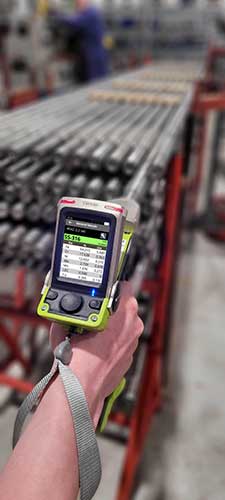How handheld X-ray fluorescence technologies can bolster quality control during the manufacture of critical metallic components.
By Mathieu Bauer, Senior Application Scientist and Associate Product Manager at Thermo Fisher Scientific
Small deviations in the elemental composition of critical metallic components used in harsh or dangerous environments can have devastating effects, leading to reduced profits, property loss, public injury, or even operator death. It is therefore crucial to employ stringent quality control methods that ensure alloys are suitable for their intended purpose. Handheld X-ray fluorescence (HHXRF) is an accessible and popular technology that is unlocking rapid and agile on-site testing for various industries, and this article describes how HHXRF can help manufacturers to streamline their quality control processes and ensure alloys meet the stringent specifications required for use in demanding applications.
The automotive, aerospace, and oil and gas sectors all make use of alloys designed to withstand extreme conditions, such as high levels of mechanical stress, elevated temperatures, and exposure to corrosive substances. Any deviation from the intended composition can have serious knock-on effects for the resulting components, making material verification a crucial part of ensuring that these materials are fit for purpose. Traditional quality control (QC) methods rely on sending samples to a laboratory for analysis, which is not only destructive but also time consuming and expensive. However, HHXRF can be used for non-destructive, on-site analysis of metals at multiple stages of the manufacturing process, delivering detailed compositional information in a matter of seconds.
Although X-ray fluorescence has been around for almost a century as a laboratory technique, it only enjoyed widespread industrial adoption after the development of early transportable analyzers in the late 1960s. Further innovation by the Niton Corporation – now part of Thermo Fisher Scientific – lead to the introduction of truly handheld instruments in 1994, with most modern iterations now weighing less than two kilograms and possessing superior analytical capabilities. The introduction of silicon drift detectors, for example, has vastly improved sensitivity – extending the range of elements that can be analyzed down to the atomic number 12 (magnesium) – and high-power tubes and detectors with graphene windows have increased detection speed for light elements.
Modern HHXRF analyzers offer ‘point-and-shoot’ analysis to produce a detailed breakdown of material composition, and can identify specific alloy grades by comparing the results to internal material libraries. These capabilities make HHXRF suitable for material verification at multiple stages of the manufacturing process, allowing issues to be identified earlier than ever before. The technology can be used to analyze exotic alloys – such as CSMX-4 and other proprietary materials that contain uncommon elements, such as rhenium and tantalum – as well as measuring the concentration of more common alloying elements. This can help distinguish between similar material grades, each suited to differing applications.

HHXRF is also gaining traction in industries that use functional coatings to enhance properties such as conductivity, solderability, lubricity or corrosion, wear and heat resistance. In the automotive industry, for example, conversion coatings have long been applied as a pretreatment to bodywork and other components made of steel and galvanized steel. Zirconium- and titanium-based materials are rapidly becoming the coatings of choice, largely replacing traditional phosphate-based options that are both less environmentally friendly and less effective. It is vital to ensure that these coatings are consistent, as needlessly thick layers will increase manufacturing costs, while insufficient coating depth could result in catastrophic product failure, especially in aerospace applications. Historically, coating QC involved taking samples at different points in the manufacturing process, then analyzing them in the laboratory, but HHXRF allows this to be done on site and in near real time. For example, the Thermo Scientific™ Niton™ XL5 Plus Analyzer can measure the thickness of up to four coating layers over a substrate – such as metal, alloy, plastic or wood – with non-destructive analysis in just seconds.
HHXRF analyzers have truly revolutionized material verification, allowing operators across a wide range of industries to quickly and accurately identify even the most exotic alloys with minimal technical knowledge or training. These portable instruments can be used throughout the entire manufacturing process, adding an extra layer of quality control and giving operators peace of mind that critical metallic components are fit for purpose.

Mathieu Bauer is a senior application scientist and associate product manager at Thermo Fisher Scientific. He holds a PhD in analytical chemistry from University of Hamburg, and has over 20 years of experience working with spectroscopy, including handheld X-ray fluorescence (HHXRF).
In this episode, I sat down with Beejan Giga, Director | Partner and Caleb Emerson, Senior Results Manager at Carpedia International. We discussed the insights behind their recent Industry Today article, “Thinking Three Moves Ahead” and together we explored how manufacturers can plan more strategically, align with their suppliers, and build the operational discipline needed to support intentional, sustainable growth. It was a conversation packed with practical perspectives on navigating a fast-changing industry landscape.